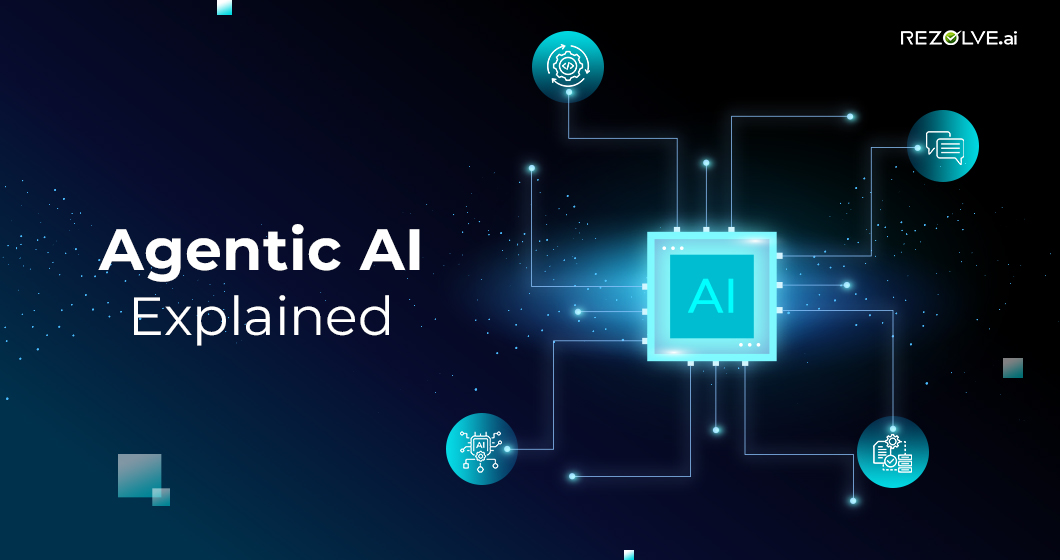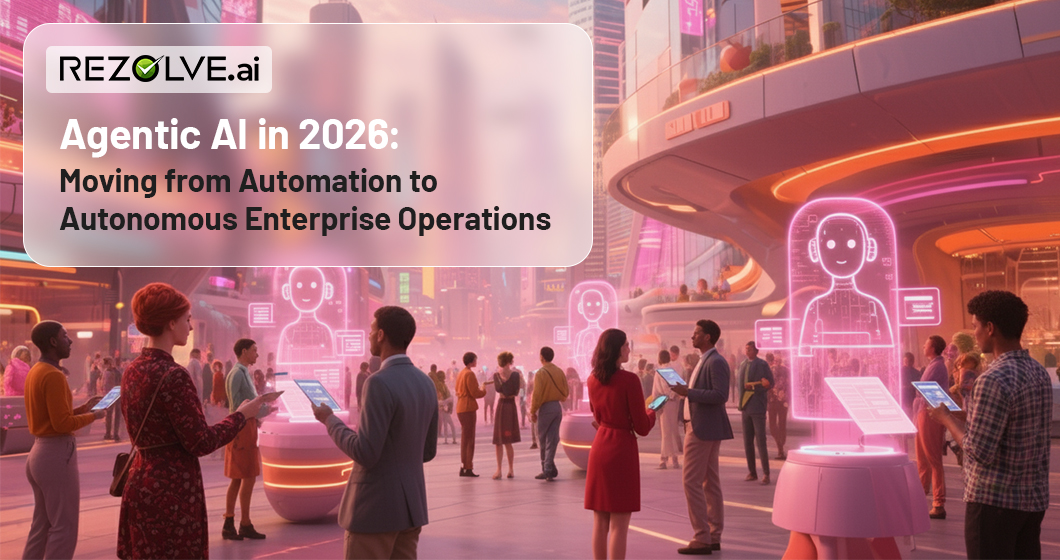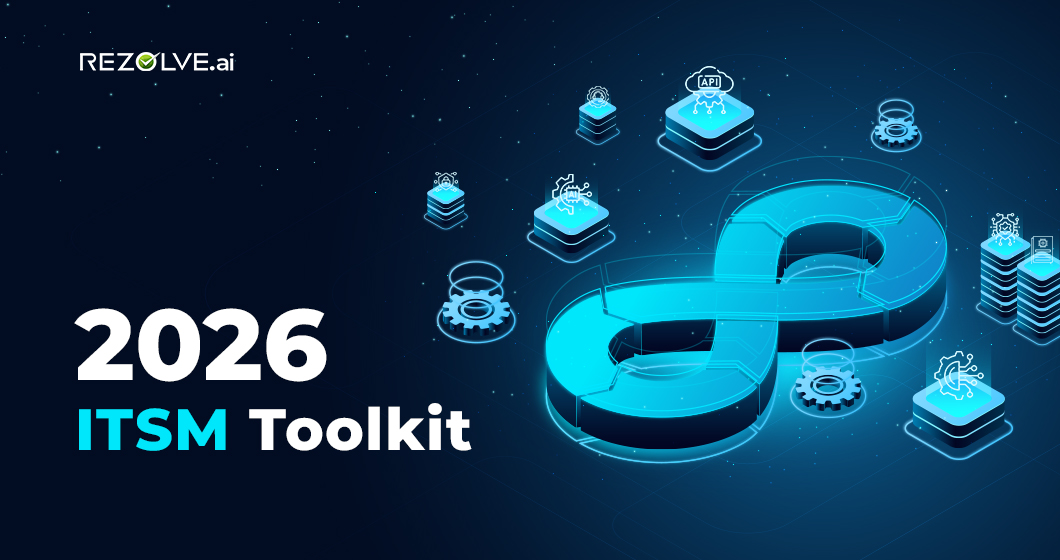Enterprise chatbots rarely move revenue or cost needles on their own. The disconnect is simple conversation minus action. Agentic AI fixes that gap by giving software the autonomy to interpret intent, devise a plan, call the right systems, and deliver a finished outcome without waiting for a human to push every button.
As Gartner flags agentic AI among its top strategic trends, service-desk and HR leaders face a pivotal choice: bolt on another FAQ bot, or redesign support around outcome-driven AI. This guide dives deep into the concept, unpacking what agentic AI is, how its layered architecture works, which tool stacks make it practical, where the highest ROI sits in IT and HR, and the guardrails that keep autonomy safe.
What Is Agentic AI?
At its heart, agentic AI is AI with initiative. Instead of merely supplying answers, an agentic system absorbs a user’s goal—“restore my VPN” or “approve this PTO request”—and owns the journey from diagnosis to resolution. It does four things in a tight loop:
- Understands intent through natural-language parsing.
- Plans a sequence of sub-tasks needed to reach the goal.
- Executes each step by invoking approved APIs, scripts, or downstream services.
- Learns from feedback to fine-tune future decisions.
That functional scope puts agentic AI one league above two earlier paradigms:
- Rules-based chatbots were essentially decision trees wrapped in a chat UI—handy for distributing links, hopeless at fixing problems.
- Standalone generative models can write fluent text or code but stop at the threshold of action; a human still has to copy, paste, and run.
By contrast, an agentic AI system fuses the comprehension of an LLM with the muscle of workflow automation, memory, and policy awareness. It becomes a virtual colleague that closes the ticket.
Agentic AI Architecture
1. Goal Ingestion & Understanding
Every interaction begins with free-form language, like voice, chat, or email. An interpretation layer (often an LLM fine-tuned on enterprise vocabulary) translates that request into a structured intent object. Policy filters immediately discard or modify any out-of-bounds requests to honor security and compliance mandates.
2. Planning & Reasoning
Next, a planning engine decomposes the intent into an ordered task graph. The system weighs alternative paths, consults organizational norms, and stitches together a viable game plan. Memory modules contribute to historic context: Has this user hit VPN limits before? Did a similar fix work yesterday?
3. Tool Integration & Execution
Plans have value only if they trigger a real change. A dedicated executor invokes a vetted catalogue of actions, like password resets, server reboots, and HR record updating.
4. Learning & Adaptation
After execution, success metrics (latency, resolution rate, CSAT) flow into a feedback layer. Fine-tuning, reinforcement learning, or simple rules updates ensure the agent iterates toward faster and safer outcomes over time.
Key Tools and Platforms that are part of the Agentic AI Architecture
The boom in autonomous agents would be impossible without a fast-maturing ecosystem of frameworks and tools.
- Large Language Models such as GPT-4, Claude, or open-source Llama 2 supply state-of-the-art comprehension and reasoning. Their role is the “mind.”
- Agent Frameworks & Libraries—LangChain, Autogen, OpenAI Function Calling, Hugging Face Agents—act as operating systems for agent workflow. They manage memory, planning loops, tool calling, and prompt templates so teams can focus on business logic.
- IBM Watsonx Orchestrate, and similar offerings wrap governance, authentication, and connector marketplaces around LLM agents, letting companies embed autonomy into finance, sales, or HR workflows without ground-up coding.
- Specialized Plugins extend core agents: computer-vision models parse screenshots for IT support; anomaly-detection models drive AIOps; vector-search engines power retrieval-augmented generation so answers stay fact-based.
Use Cases in ITSM and HR
While agentic AI has broad potential, employee-facing support desks offer an unusual mix of high volume, clear rules, and measurable ROI.
IT and HR teams juggle floods of repetitive requests: creds fail, laptops lag, policies confuse new hires. Humans excel at empathy and judgment, yet a shocking share of their day disappears into password-reset clicks and policy copy-pasting. Agentic AI can relieve that burden, turning the service desk from a reactive hotline into a proactive productivity engine.
1. Level 1 IT Support Automation
Routine tickets—access grants, software installs, printer configs—eat time but seldom require deep expertise. An agentic bot can authenticate a user, invoke a reset API, install software via endpoint-management tools, and close the ticket inside a Microsoft Teams chat. Early adopters report 35–50 % of all IT tickets resolved automatically, shaving average resolution time from days to minutes and recouping six-figure labor costs.
2. Proactive IT Operations (AIOps)
Beyond fixes, agents can prevent incidents. By analyzing log streams and monitoring dashboards, an AIOps agent forecasts SLA breaches, spins up extra capacity, or rolls back a faulty release before customers notice. The payoff is lower mean-time-to-detect and fewer 3 a.m. “all-hands” calls.
3. HR Employee Service
HR departments field repetitive queries about leave rules, benefits, and payroll details. An agentic HR assistant answers those questions with policy-grounded accuracy, updates Workday records, and shepherds approvals through Slack. Companies leveraging such agents see 90%+ automation of tier-1 HR interactions.
4. Knowledge-Driven, Personalized Support
Because agents tap enterprise search, they tailor answers to role, device type, or history: a marketer gets a OneDrive link, while an engineer receives a Git credential rotation script. This level of context transforms the help-desk experience from scripted to bespoke, returning hours of productive time to every employee each month.
Ethics and Guardrails
Giving software the keys to core systems is powerful—and risky. A robust ethical framework ensures autonomy does good, not harm.
Permission Boundaries
Every agent operates under least-privilege credentials and a whitelisted action set. Sensitive tasks—mass user deletion, finance updates—trigger mandatory human approval or are entirely off-limits.
Accuracy & Hallucination Control
Retrieval-augmented generation grounds answers in verifiable documents; citation links let users inspect sources. Secondary validation models or rule-based filters catch improbable or non-compliant outputs before execution.
Auditability & Oversight
Comprehensive logs capture each decision, API call, and result. Admin consoles surface “why” explanations so auditors can trace logic. Scheduled reviews watch for drift or bias, mirroring financial-controls discipline.
Bias Mitigation
Training data is scrubbed and continuously audited. For HR scenarios, fairness algorithms monitor for discriminatory patterns in ticket prioritization or leave approvals, ensuring the agent’s “efficiency” never comes at the price of equity.
Fail-Safes & Escalation Paths
If an agent stalls, loops, or encounters an unfamiliar scenario, it times out gracefully and hands the case to a human with a full summary. This reflex prevents tickets from languishing in limbo.
Rezolve.ai’s Agentic Sidekick 3.0: Hands-Off Support Inside Teams & Slack
Agentic Sidekick 3.0 lives natively in Microsoft Teams and Slack, meeting employees in the same chat pane they use all day. A single plain-language request—“unlock my VPN” or “update my mailing address”—kicks off its agentic loop: the model parses intent, plans every sub-task, calls the right ITSM or HR systems, and closes the ticket without bouncing the user to a help-desk queue. Because the bot blends large-language-model reasoning with retrieval-augmented search across SharePoint, Confluence, and other knowledge stores, it answers with source-linked facts and launches automations only after cross-checking the data.
Execution is its true edge. A library of vetted actions, like password resets, software installs, HRIS updates, device-level scripts lets Sidekick shoulder 30-70 percent of Level 1 IT and HR tickets. Out-of-the-box connectors for Active Directory, Office 365, Workday, and dozens of SaaS apps mean most teams spin up a production pilot in weeks, not quarters.
Governance stays front-and-center. The AURA Insights module monitors live ticket streams for looming SLA breaches and suggests fixes, while data-loss-prevention rules, least-privilege credentials, and click-through “why” panels keep security and audit teams comfortable with every decision the AI makes.
In Closing
Agentic AI has moved from hype to daily utility, and Rezolve.ai’s Agentic Sidekick 3.0 shows how: it meets employees where they already work, solves problems end-to-end, and stays within the guardrails enterprises demand. Start with one high-volume workflow—say, password resets or PTO approvals—measure auto-resolve rates, MTTR, and CSAT, then expand once the numbers speak for themselves. If you’re ready to see a service desk that never sleeps or stalls, book a live demo of Rezolve.ai’s Agentic Sidekick 3.0 and experience hands-off support in action.





.webp)




.jpg)

.png)








.png)